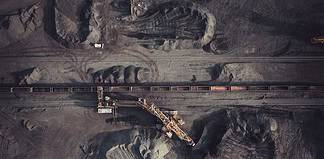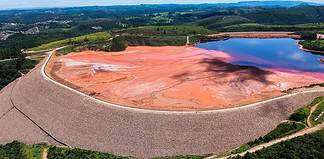Southern Ports services a 400,000km2 area in WA – bigger than the land size of Germany.
Created in 2014 through the amalgamation of the three WA ports of Albany, Bunbury and Esperance, Southern Ports looks after all sea trade in the southern and southwest regions of WA.
Main goods traded through the three ports include minerals, grains and wood products.
The commencement of the new Executive Leadership Team (ELT) in 2020 saw Southern Ports achieve a very successful FY20, reaching a total trade of 32.2mt, which is a 13% increase from the year before.
Southern Ports chief executive Steve Lewis says the resilience of its customers through COVID-19 played a significant part in the positive outcome for the organisation.
“Trade held up very well and the standouts were Mineral Resources doing better than budgeted in terms of their throughput through Esperance port,” he said.
“Alcoa Worsley in Bunbury continued to exceed and maintain their alumina exports.
“Albany has been supporting Grange Resources and their Southdown project through de-risking work, reducing capital costs down and examining what their export profile might look like.”
The Port of Albany does not traditionally trade major minerals and, with Southdown planned to come online around 2025, there will be an additional 5mtpa of magnetite concentrate exported through the port.
With a total of 14 berths among the three ports, Southern Ports contributes over $9b to the economy.
Profit before tax in FY20 was $55.8m, an increase of 70% from FY19, while total revenue jumped 31% to $149.5m.
Master Planning
Five pillars drive the strategic direction of Southern Ports: trade development, supply chain, sustainability, port development and innovation.
Master planning for all three ports is underway as part of Southern Ports’ port development strategy.
“Port development is important as it’s all about keeping up with the future, where technology is going, including the future direction of the shipping industry and sustainability goals,” Mr Lewis said. “They’re all wrapped up into master planning.”
With the newly created General Manager Port Development role, Southern Ports is also recruiting engineering, asset management and project and planning expertise to its port development team.
“This team will add great value in the new year with our input to Infrastructure WA, the delivery of key capital projects and supporting our strategic growth plans,” Mr Lewis said.
WA Premier Mark McGowan is the minister responsible for Infrastructure WA, for which one of the government agency’s responsibilities includes delivering the State Infrastructure Strategy to address infrastructure needs and priorities for the next 20 years.
“We started master planning in Esperance a few months ago and we’re just about to start Bunbury in January 2021, with announcements on Albany starting in early February 2021,” Mr Lewis said.
“All the master planning is targeted to be completed by 30 June next year, or even a few weeks after, if necessary, to ensure quality of the outcome.
“It’s going to define the development path for each of the ports based on trade projections for the next 20 years and, therefore, the development of our 10-year investment plan.”
By this time next year, all three ports will be in good stead with their development plans.
Southern Ports is spending $60m over the next two years to renew assets at all three ports and improve their supply chains.
“The $60m for all three ports is a big program for us,” Mr Lewis said. “We will be improving the drainage and roads in Esperance and improving some of the Berth 8 facilities in Bunbury, including the wharf and road network there, for a more efficient movement of trade.”
Supply Chain
In early 2020, Southern Ports rolled out a project using geographic information system (GIS) to look into its supply chain at all three ports, digitally representing where all its customers and trades were.
“We now have a very good understanding of the supply chain and where are some of the investments are outside of the port that we can recommend to government or our customers,” Mr Lewis said.
“The use of technology and very up-to-date GIS picturing has been very illuminating for the organisation and provided us deep and detailed insight on our supply chain.
“I think ports do their best work outside their fence and, we have a very good running port, but at the same token it’s those supply chains, those rail and road and pipelines that really add to the efficiency of our customers, and we’re doing a lot of work in that.”
Trade Development
Mr Lewis says trade development is a primary role of ports and the challenge is marketing the capacities of the port more effectively.
“Our work in trade development is making sure we promote the capacities we have, using the WA trade offices in various international locations and building on the synergies we have already,” he said.
“We have very good relationships with the WA Department of Jobs, Tourism, Science and Innovation (JTSI) and with our customers.”
Southern Ports is working with customers to determine what technology the ports could implement. It currently employs drones, uses augmented reality and is exploring the future and changing face of shipping including international environmental standards for fuel.
“We are getting ourselves in good shape for the future and ensuring our customers can also continue trading through our ports with confidence, knowing that we’re working with them to build trade and opportunity,” Mr Lewis said.
Sustainability And Innovation
Sustainability is one of the five pillars. Initiatives at the Port of Albany have to-date reduced waste, weeds, contaminants, heritage and water.
“We aspire to create sustainable ports and in this new year we will build from the bottom up sustainability work our Albany team has successfully undertaken,” Mr Lewis said.
“We are very much a port around intergenerational assets, making sure we put the port in good shape for future customers, from environment to heritage and also how we bring technology in to make the ports viable.”
Innovation is another focus pillar and includes improvement in processes and systems.
“We build upon the work our Esperance team has done this year in experimenting with thinking smarter about how they go about their work, looking at all technology and expanding this across all of our ports,” Mr Lewis said.
Bunbury
Bunbury is WA’s second city by population, making the Port of Bunbury significant in terms of the support it provides the State.
Goods traded through the Port of Bunbury include alumina, caustic soda, methanol, tugboats, woodchips and bulk materials.
“The port has the largest land holdings of any port in Australia at 474ha and there is a real good opportunity for the port to develop over time to take some of the Perth freight task,” Mr Lewis said.
The WA Government endorsed the independent Westport Taskforce’s recommendation for a future container port to be built within the Kwinana Industrial Area by 2032 as part of long-term solutions for Perth’s future freight needs.
“There’s still a lot of opportunity for us to make sure the Port of Bunbury is ready for various trades that might come to Bunbury, particularly some of the bulk trades between Fremantle and Bunbury,” Mr Lewis said.
There are further plans for the Port of Bunbury to support trade coming out of the potential Advanced Manufacturing Hub touted for WA’s Southwest region.
Feasibility studies are underway by the WA Government to build a facility within the Bunbury Geographe area as part of its efforts to bring more manufacturing back to the State.
The WA Government has also invested $15.5m in the new Turkey Point Bridge in Bunbury, with the aim of completion by June 2022, marking the first stage in the Port of Bunbury’s expansion plans.
The new bridge and road will provide alternative access to the Port’s northern berths and will support the future construction of Berth 10 and rail expansion plans.
“There are additional berths at the Port of Bunbury if a customer needs them, the Port is currently running very efficiently and, in terms of development, the capacity can be developed incrementally,” Mr Lewis said.
“The scheduling in Berth 8, which is our busiest berth and takes large amounts of minerals, has delivered coordination and significant cost savings to customers of the facility over the last 12 months.”
Albany
The Port of Albany is the oldest port in WA, with grain and woodchips being the main goods traded.
“It’s a very good port, with a high tourism element, and it is historically tied to the town of Albany,” Mr Lewis said.
“This brings a real commitment on Southern Ports’ part to develop the Port in a way that is commensurate with the town.”
There has been a complete moratorium on cruise shipping since COVID-19 began.
“Berths 1 and 2 have been set up to support cruise shipping and it’ll be good to see the return of this industry at the Port of Albany,” Mr Lewis said.
“Tourism is an important industry in WA but also the Port of Albany.
“The Port is also ready to support Grange Resources’ Southdown magnetite project when it comes online.
“We are currently looking at the land adjacent to Berth 6 in Albany to see whether it can be better configured to support a more efficient supply chain for some of the smaller trades at the Port.”
Esperance
The Port of Esperance is a deep-water port that can cater for Cape size vessels up to 200,000t.
A $54m upgrade in 2002 made it the deepest port in southern Australia and the largest exporter of nickel concentrate in the Southern Hemisphere.
Goods traded through the Port include iron ore, nickel, grain, fuel, fertilisers, sulphur, spodumene, copper and woodchips.
Rail connection to Esperance is important as the Port services mines and facilities up to 700km away including areas such as Yilgarn, Kalgoorlie, Leonora and Koolyanobbing.
“Master planning at the Port of Esperance began a few months ago,” Mr Lewis said.
Drainage and roads in Esperance will be improved as part of Southern Ports’ $60m investment over the next two years amongst each of its three ports.
“The Port is also cognizant that it could be quicker for some of the miners in South Australia to look at potentially coming through Esperance,” he said.
“We take a wide view of expansion, including supporting these mines to get their products out through the Port of Esperance.”
Current clients of the Port include CBH and Mineral Resources, which recently achieved a throughput run rate of 11.5mtpa in June 2020.
Today, a total of 200 ships and 11mt of trade passes through the Port of Esperance each year.








































